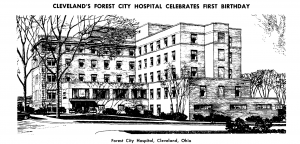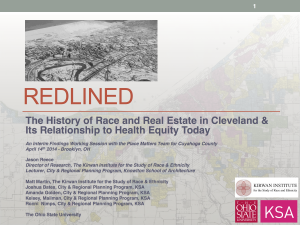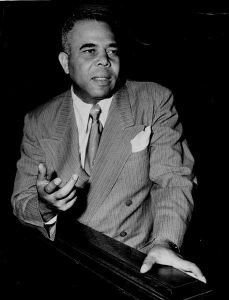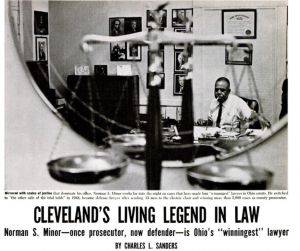Approaches to Black Power: African American Grassroots Political Struggle in Cleveland, Ohio, 1960-1966
David M. Swiderski
University of Massachusetts Amherst, dswiderski@gmail.com
www.teachingcleveland.org
Approaches to Black Power: African American Grassroots Political Struggle in Cleveland, Ohio, 1960-1966
David M. Swiderski
University of Massachusetts Amherst, dswiderski@gmail.com
Jane Edna Hunter and Black Institution Building in Ohio by Virginia R. Boynton
Google book link here
From: Builders of Ohio: A Biographical History
edited by Warren R. Van Tine, Michael Dale Pierce, Michael Cain Pierce
Cleveland-A Black Hospital at Last By Vanessa Northington Gamble
Chapter from: Making a Place for Ourselves: The Black Hospital Movement, 1920-1945 By Vanessa Northington Gamble

Cleveland’s Forest City Hospital Celebrates First Birthday
March 1959 Journal of the National Medial Association
https://www.ncbi.nlm.nih.gov/pmc/articles/PMC2641466/?page=1
Link to on-line article here
The History of Race and Real Estate in Cleveland, Ohio by the Kirwan Institute 2014
The link is here
Full presentation is here (web version)
The pdf is here (26mg)

The Moral Implications of Regional Sprawl by Bishop Anthony Pilla 1996
America prides itself on being a melting pot, and for more than a century virtually unrestricted immigration filled the country with residents from around the world. But war, racism and the fear of radical political movements led to legislation that drastically limited immigration from WWI to the 1960s.
Learn more about the historical forces that closed the nation’s doors and the impact that legislation had on ethnic and national groups who sought refuge here, with Case Western Reserve University professor and editor of The Encyclopedia of Cleveland History, Dr. John Grabowski.
This program is part of the 2014-2015 Cleveland Jewish History and Public Policy Series co-sponsored by Cleveland Jewish News Foundation, The Laura and Alvin Siegal Lifelong Learning Program at Case Western Reserve University, Teaching Cleveland Digital and the Maltz Museum of Jewish Heritage.

Norman S. Minor (1901-1968)
Norman S Minor was an African-American attorney, originally a prosecutor and then a defense attorney. He helped to train a number of Cleveland’s prominent black attorneys including Louis and Carl Stokes
The late Congressman Louis Stokes who trained under Mr. Minor called him the “Greatest criminal trial lawyer this state has ever known” in this interview (12:32)
From Cleveland.com
Norman S. Minor, was Cuyahoga County’s 1st black assistant prosecutor: Black History Month
From Encyclopedia of Cleveland History:
MINOR, NORMAN SELBY (19 July 1901-15 May 1968), noted criminal trial attorney under whom a number of Cleveland’s prominent black attorneys, including Merle McCurdy and Louis and CARL STOKES, trained, was born in Oak Park, Ill., to Arthur and Rebecca Walden Minor. He came to Cleveland when he was 4. After 2 years at the University of Michigan, he graduated with an LL.B. degree from John Marshall Law School in 1927, and was admitted to the Ohio bar in 1928. From 1928-30, Minor was associated with the firm of Payne, Green, Minor, & Perry, taking cases of men in jail who needed a free lawyer in order to gain trial experience. Appointed assistant Cuyahoga County prosecutor in 1930, he was assigned to cases in which the defendants were black since the discriminatory system at the time limited general use of his skills. He worked effectively to change the policy for subsequent black prosecutors and, despite discrimination, became one of Cleveland’s best criminal trial lawyers. He prosecuted more than 5,000 felony cases, including 13 successful prosecutions for 1st-degree murder, his most famous case being that of Willie “The Mad Butcher” Johnson, convicted of murdering 12 women during the 1930s and 1940s. Involved in Democratic party politics, Minor polled the largest vote of any black candidate to that time in a 1937 election defeat for a municipal court judgeship. In 1948 Minor returned to private practice as a criminal defense lawyer specializing in homicide cases.
Minor married three times and had two children. He had a son, Harold Craig (Green) Minor (b.1921-d.1988); a daughter, Valena (Williams) from the Feb. 1922 marriage to Grace C. Jones which ended in divorce in 1926. Minor married Norvell Major (d. 1937) in 1928; and in 1938, Minor married Mary Christian. He is buried in LAKE VIEW CEMETERY.
Obituary from Plain Dealer
http://teachingcleveland.org/wp-content/uploads/2017/07/norman-minor-obit-1968.png
Ebony Magazine article on Norman S. Minor, November 1963
Click here (8mg pdf)

Incredible quote from Ebony essay:
“(Minor) has been either the prosecutor or the defense lawyer in almost every heinous crime committed in Cleveland since 1930, the year he began his trial work.”
Google books link is here
Cleveland Cultural Gardens from the Encyclopedia of Cleveland History
The CLEVELAND CULTURAL GARDEN FEDERATION oversees the Cultural Gardens, landscaped gardens with statuary honoring various ethnic groups in Cleveland situated along East Blvd. and Martin Luther King, Jr., Blvd.
|
|
The CCGF was founded in 1925 as the Civic Progress League by LEO WEIDENTHAL†, who, during the dedication of the Shakespeare Garden in ROCKEFELLER PARK in 1916, felt that similar sites should be prepared for each of the city’s nationality communities. In 1926 the organization became the Cultural Garden League, and a Hebrew garden was established. On 9 May 1927 the city set aside areas of Rockefeller Park for future gardens. The Italian, German, Lithuanian, Slovak, and Ukrainian gardens were established in 1930; the Polish, Hungarian, Czech, and Yugoslav gardens in 1934; and the American, Rusin, Irish, Greek, and Syrian gardens in 1938. Romanian, Estonian, Afro-American, Chinese, Finnish, and Indian gardens have since been created. Planning and fundraising for each garden was undertaken within the various ethnic communities, while the Cleveland Cultural Garden Fed. (the name adopted in 1952) oversaw overall planning and coordinated various joint programs, including the 2nd UNESCO Conference (1949) and the annual One World Day (begun in 1945). During the 1960s and 1970s, many gardens suffered vandalism and statuary was removed for safekeeping. In 1985-86 a major restructuring of the area was undertaken and plans discussed for rehabilitating the gardens by the federation, including 40 members from the affiliated nationalities. In the 1990s, the federation’s bylaws were rewritten so that each member group had 2 members and an alternate member on the Federation Board. Richard J. Konisiewicz served as president of the federation, which maintained 25 sites in 1995.
Cleveland Cultural Garden Fed. Records, WRHS.
Lederer, Clara. Their Paths Are Peace (1954).
“Pride and Prejudice” Plain Dealer Sunday Magazine article about Cleveland Cultural Gardens Sunday August 11, 1985 by Madeline Drexler